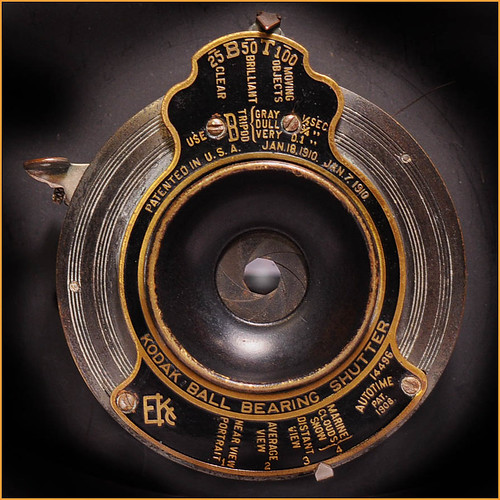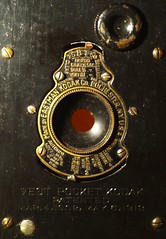Difference between revisions of "Ball Bearing Shutter"
| Line 27: | Line 27: | ||
|image= http://farm9.staticflickr.com/8181/8035611219_cdb99775b5_m.jpg | |image= http://farm9.staticflickr.com/8181/8035611219_cdb99775b5_m.jpg | ||
|image_align= left | |image_align= left | ||
| − | |image_text= | + | |image_text= marked as patented in 1910, with piston to connect<br/>tube and bulb for pneumatic remote control<br/>and with resetable exposure counter |
|image_by= John-Henry Collinson | |image_by= John-Henry Collinson | ||
|image_rights= (C) | |image_rights= (C) | ||
Revision as of 19:20, 9 October 2012
The Ball Bearing shutter was very common on old Kodak cameras. It appeared when Kodak wanted to become more independent from suppliers of shutters and lenses like Bausch & Lomb. Many Kodak cameras of that time got a Kodak shutter but still a Bausch & Lomb lens or vice versa. The Ball Bearing Shutter is a five-blade leaf shutter, often with choice between two or three instant speeds plus bulb and time mode. It has a screw mount for a remote cable. The Ball Bearing shutter is famous for its odd speed selection scale with the B mode between the first and the second instant speed, and the T mode between the second and the third instant speed. The shutter unit also contains a ten-blade diaphragm. The aperture scale may be given as U.S. stops, with the 4 equivalent to f-stop f8 and the 64 equivalent to the f-stop f32. Another variant is Kodak's special 1-2-3-4 aperture scale on non-focusable cameras, with written hints which aperture is dedicated to which situation. This scale was often used on small consumer cameras with the small shutter variant with three shutter blades and eight aperture blades. At least one variant of the shutter hat a built-in exposure counter so that the photographer could always control whether the number in the shutter's counter equals that in the camera's red window before exposure. Thus no exposure could get lost by accident.

|
| marked as patented in 1910, with piston to connect tube and bulb for pneumatic remote control and with resetable exposure counter image by John-Henry Collinson (Image rights) |
Links
- Ball Bearing shutter in detail at Camera Collecting and Restoration [1]
- repair instructions on vintage-camera-repair [2]


